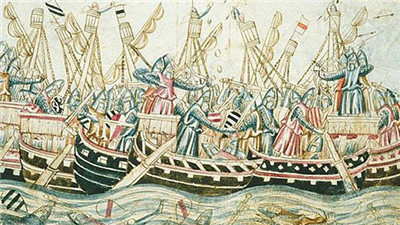2、Death-Bringing Plague Ships
帶有致命瘟疫的船只
As we mentioned earlier, the plague sometimes traveled from one area to another by ship, and this was actually one the quickest ways in which it spread. In 1347, Italian ships spread the plague from Constantinople to Alexandria to Marseilles and then on to Venice, Genoa, and next on to the rest of Europe.
當我們提到早先瘟疫有是通過船只從一個地方旅行到另一個地方,并且這確實是它傳播的最快的方式。在1347年,意大利船只將瘟疫從君士坦丁堡到亞歷山大到馬賽然后到威尼斯,熱那亞然后是到歐洲其他地方。

Why didn't the trading ships just stop? Surely captains would weigh the benefits of bringing a plague-stricken crew to land against preventing the spread of the plague throughout the continent?
為什么這些貿易船只不只是停靠呢?肯定的是船長要權衡將瘟疫-是將患病的全體船員帶到陸地,還是避免讓瘟疫傳遍全大陸?
It turns out the plague was much too sneaky to allow such precautions. It would appear on ships well before making itself known. First, it would incubate, multiply, and makes the rounds of the rat population. Then it would jump to humans, and even then, it could take up to five more days to make a person ill. A trading ship could become a death ship for almost a monthbefore anyone on board would have the slightest idea anything was wrong.
然而,瘟疫的傳播是如此的悄無聲息,這樣的預防也是沒用的。它在被人們發現之前就會感染船上的人。首先,它會孵化,繁殖并且獲得老鼠種群的循環。然后他將跳到人類身上,甚至然后,他將再用五天時間使一個人患病。經過幾乎一個月,在船上的人有哪怕一丁點察覺之前,這艘貿易船就被瘟疫變成了一艘死船。
By nature, rats on a ship would largely avoid human contact. In many cases, plague-bearing fleas would find new rat hosts once ships made port or would stow away in cargo that was then taken and distributed throughout the destination city.
自然而然地,船上的老鼠會盡量避免與人類接觸。在許多情況下,感染瘟疫的跳蚤在船只靠岸時找到新的老鼠宿主或是偷乘在貨物中然后被帶到并散布到整個目的城市。











